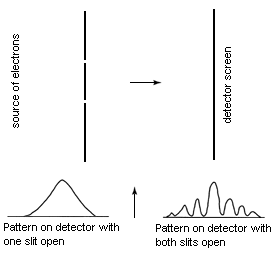Wave-Particle Duality
The photo-electric effect showed that under certain
circumstances light can behave in a particle-like manner rather than its usual
wave-like manner. The next step in the development of a quantum view of the
world was due to an aristocratic French physicist, Prince Louis de Broglie.
If light can sometimes be particle-like, might there not
conversely be situations in which sub-atomic particles behave in a wave-like
manner? De Broglie set out to search for such behaviour. He found that, if you
take a beam of electrons and pass it through a pair of slits (a classical wave
experiment), you get diffraction and interference - properties characteristic
of a wave rather than a particle. If you reduce the intensity of the electron
beam to a single electron at a time, the detector on the other side of the
slits will still gradually accumulate a trace that looks like an interference
pattern. Explaining this in classical terms is impossible - if the electrons go
through one slit or the other the pattern would look quite different.

There is a good discussion of the two-slit experiment in terms
of quantum theory in Paul Davies’ God and
the New Physics, p108-111.
Email
link | Feedback | Contributed by: Dr.
Christopher Southgate
Source: God, Humanity and the
Cosmos (T&T Clark, 1999)
|